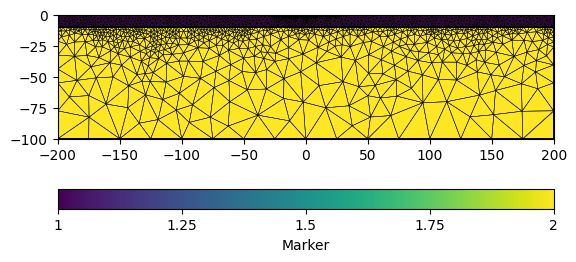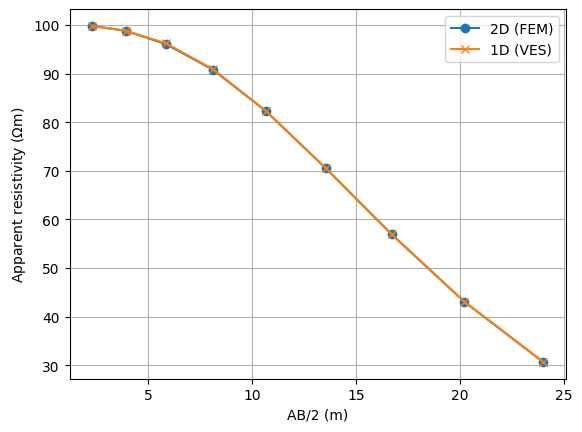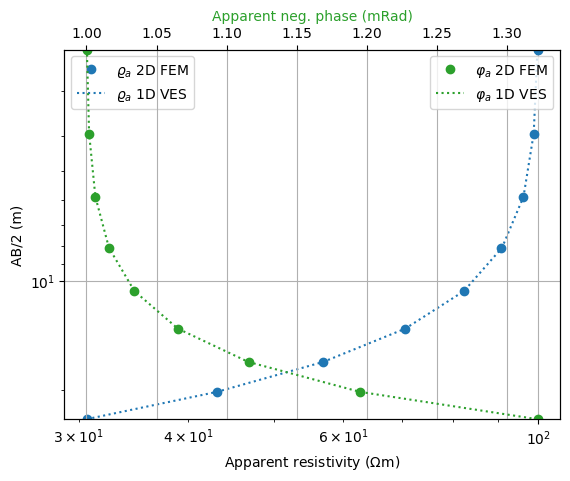Note
Go to the end to download the full example code.
2D FEM modelling on two-layer example#
Compare 2D FEM modelling with 1D VES sounding with and without complex resistivity values.
import numpy as np
import pygimli as pg
import pygimli.meshtools as mt
from pygimli.physics import ert
from pygimli.physics.ves import VESModelling, VESCModelling
First we create a data configuration of a 1D Schlumberger sounding with 20 electrodes and increasing MN/2 electrode spacing from 1m to 24m.
scheme = ert.createData(pg.utils.grange(start=1, end=24, dx=1, n=10, log=True),
sounding=True)
First we create a geometry that covers the sought geometry. We start with a 2 dimensional simulation world of a bounding box [-200, -100] [200, 0], the layer at -5m and some suitable requested cell sizes.
plc = mt.createWorld(start=[-200, -100], end=[200, 0],
layers=[-10], area=[5.0, 500])
To achieve a necessary numerical accuracy, we need some local mesh refinement in the vicinity of the electrodes. However, since we don’t need the electrode (aka sensor) positions to be present as nodes in the geometry, we only add forced mesh nodes near the electrode positions, right below the earth surface.
for s in scheme.sensors():
plc.createNode(s + [0.0, -0.2])
# Now we can create our forward modelling mesh.
mesh = mt.createMesh(plc, quality=33)
_ = pg.show(mesh, data=mesh.cellMarkers(), label='Marker', showMesh=True)

It is usually a good idea to calculate with a p2-refined mesh (A p2-refined mesh indicates that quadratic shape functions are used for the Finite-Element formulation, whereas a h2-refined mesh would simply split existing elements into smaller ones). However, you should be careful for larger meshes since the numerical effort will be highly increased.
mesh = mesh.createP2()
Perform the modelling using the static convenience call for ERT. Res is the resistivity mapping regarding the regions of the given geometry. Region with marker 1 is the upper layer, maker 2 is the background
data = ert.simulate(mesh, res=[[1, 100.0], [2, 1.0]],
scheme=scheme, verbose=False)
1D VES
x = pg.x(scheme)
ab2 = (x[scheme('b')] - x[scheme('a')]) / 2
mn2 = (x[scheme('n')] - x[scheme('m')]) / 2
ves = VESModelling(ab2=ab2, mn2=mn2)
Plot results
fig, ax = pg.plt.subplots(1, 1)
ax.plot(ab2, data('rhoa'), '-o', label='2D (FEM)')
ax.plot(ab2, ves.response([10.0, 100.0, 1.0]), '-x', label='1D (VES)')
ax.set_xlabel('AB/2 (m)')
ax.set_ylabel(r'Apparent resistivity ($\Omega$m)')
ax.grid(1)
_ = ax.legend()

We can easily repeat the above example using a complex resistivity model. defining amplitude and phase in negative mrad.
amps = np.array([100.0, 1.0])
phases = np.array([1.0, 10.0])
res = amps - 1j * amps * np.sin(phases/1000.)
data = ert.simulate(mesh, res=[[1, res[0]], [2, res[1]]],
scheme=scheme, verbose=False)
ves = VESCModelling(ab2=ab2, mn2=mn2)
rc = ves.response([10.0, 100.0, 1.0, phases[0]/1000, phases[1]/1000])
We can apply the default drawing routines for 1D VES data as well.
fig, ax = pg.plt.subplots(1, 1)
ves.drawData(ax, pg.cat(data('rhoa'), -data('phia')),
labels=[r'$\varrho_a$ 2D FEM', r'$\varphi_a$ 2D FEM'],
marker='o', linestyle='none')
ves.drawData(ax, rc,
labels=[r'$\varrho_a$ 1D VES', r'$\varphi_a$ 1D VES'],
marker=None)
np.testing.assert_approx_equal(data('rhoa')[0], 30.66351249, significant=5)
np.testing.assert_approx_equal(-data('phia')[0], 0.00132173865, significant=5)

numpy.testing.assert_approx_equal